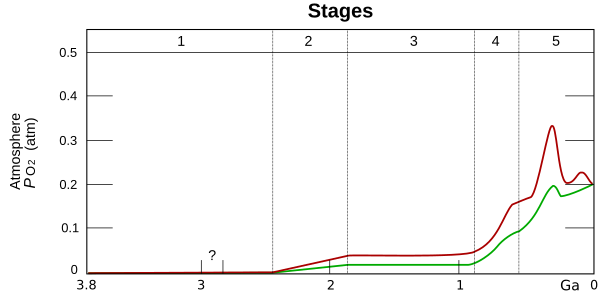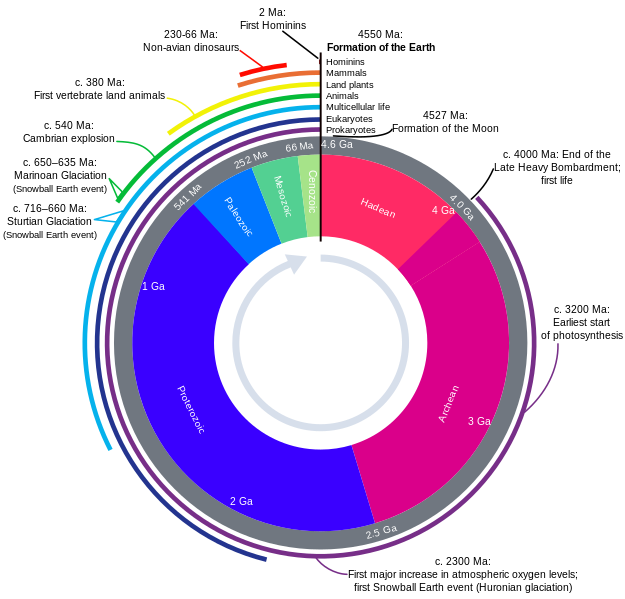How early was the Earth liveable for today's humans?
Say you were to drop a (bunch of) human(s) at some past era of our Earth. I'm assuming they might encounter a few problems such as the composition of the air not being breathable, the water being too rich or too poor in some chemicals, some diseases being totally new to their immune system... Maybe they themselves bring some diseases from the present and eradicate all source of food...
My question is: how early could they be dropped and still have a chance of survival?
This post was sourced from https://worldbuilding.stackexchange.com/q/4156. It is licensed under CC BY-SA 3.0.
1 answer
I love this one. I really do.
Quick Answer:
I'd put the date at roughly 2.3 billion years ago, give or take. This is the date of the Great Oxygenation Event. It's when organisms (bacteria) began putting oxygen into the atmosphere in large quantities as a waste product of photosynthesis. The atmosphere before that has a lot of carbon dioxide, which wouldn't have very good for our intrepid explorers. But this new one sort of resembled the one we have today, although the nitrogen from the earlier atmosphere is still here. This graphic gives you a sense of how high oxygen levels were:

Image courtesy of Wikipedia user Loudubewe under the Creative Commons Attribution-Share Alike 3.0 Unported license.
The red and green lines represent the high and low estimates of oxygen levels. Note that this atmosphere would only have been about 5% oxygen, as opposed to the 20% we have today. To reach that, you'd have to go back less than a billion years from the present date.
Long Answer:
This is really just a bunch of additional details that aren't quite as important (okay, I guess they are).
As Neil mentioned, humans need food. And 2.3 billion years ago, there wasn't much of that around. In fact, there wasn't much life around. To make this an even more graphics-heavy answer, I have this chart, which shows you just how bacteria dominated our planet:
It took multicellular life another 750 million years or so to arrive after the Great Oxygenation Event. So the day's meals would be bacteria. But human's can't really live on bacteria, so our intrepid explorers would have to wait until the Cambrian Explosion 542 million years ago, when land plants formed. Aside from that, they could try to catch some aquatic creatures (trilobite stew, anyone), but it would be hard.
Another problem with dropping our explorers off 2.3 billion years ago would be that the Earth may have been undergoing a repeating phase in its life known as the Snowball Earth phase (in this case, the Huronian Glaciation). Large portions of the planet were covered in ice, making the planet pretty inhospitable.
Mark Adler pointed out that carbon dioxide levels are also important, as levels above 5% are toxic to humans. Currently, it's at roughly 0.0397%, or 397 parts per million. In years prior, that number was a lot higher. This graphic indicates that carbon dioxide levels would not have been favorable until a few hundred million years ago:

Image courtesy of Wikipedia user Merikanto~commonswiki under the Creative Commons Attribution-Share Alike 3.0 Unported license.
So 300 million years ago, there was a favorable "island", but that soon went away. You'd have to wait a while longer before levels returned to what they are today.
As a few users have pointed out (all correctly), oxygen levels need to be at least 10% for humans to not suffer severe medical issues, and carbon dioxide levels need to be below 5%. These conditions weren't necessarily satisfied at the beginning of the Great Oxygenation Event. However, they changed over time. Over the course of Earth's history, there were periods where these conditions became more (or less) conducive to human life. I'm reluctant to pick an exact date, so I'll instead post these graphs (taken from here, and found individually here and here). I'm not positive of their accuracy, but they'll do. I won't post them, though, because at least one is copyrighted, and so I can't reproduce it here.





















0 comment threads